Tourism in South Korea

| History |
|---|
| Business culture |
| Industries |
| Regional |
| Related topics |
The tourism industry in South Korea caters to both foreign and domestic tourists. In 2012, 11.1 million foreign tourists visited South Korea, making it the 20th most visited country in the world, and the 5th most visited in Asia.[1][2] Most non-Korean tourists come from other parts of East Asia such as Japan, mainland China, Taiwan, and Hong Kong. The recent popularity of Korean popular culture, often known as the "Korean Wave", in these countries has increased tourist arrivals.[3] Seoul is the principal tourist destination for visitors; popular tourist destinations outside of Seoul include the major coastal city of Busan, the Seorak-san national park, the historic city of Gyeongju and subtropical Jeju Island.[4]
Korean tourism industry
The majority of the South Korean tourist industry is supported by domestic tourism. Thanks to the country's extensive network of trains and buses, most of the country lies within a day's round trip of any major city. International tourists come primarily from nearby countries or regions in Asia. Japan, mainland China, Hong Kong and Taiwan together account for roughly 75% of the total number of international tourists.[5] In addition, the Korean Wave has brought increasing numbers of tourists from Southeast Asia and India. The Korea Tourism Organization (KTO) is targeting 100,000 arrivals from India in 2013.[6]
Travel destinations of Korean tourists
The number of Korean domestic tourists has increased since 2010. The number of people who participated in domestic travel (which includes one-day trips) was about 238.3 million (in 2015). It increased by 4.9% compared to 2014 (227.1 million).[7] In 2014, Korean's domestic tourism expenditure was ₩14.4 trillion.[8]
Also, Korean oversea tourists keep increasing since 2010. From 2012 to 2014, the number of people travelling overseas has risen by about 8.2% on average. In 2014, number of Korean oversea tourists was about 16.1 million. And Korean oversea tourism expenditure was $19,469.9 million.[9]
History
In the past, South Koreans were not likely to travel overseas, due to the Korean War and subsequent economic difficulties, as well as government restrictions on overseas travel, with passports issued only for a narrow range of reasons, such as traveling abroad on government businesses, for technical training, and so on. Since the 1960s, overseas travel restrictions and regulations have been continuously reviewed to prevent foreign currency waste from traveling abroad. However, during the 1980s, the liberalization of international travel has begun to take place in catering to the globalization of the South Korea society. Since then, South Koreans have been able to travel freely abroad.[10]
The busy lifestyle of modern South Koreans, leading to difficulties in mediating vacations with family or friends, and the increase in one-person households, have contributed to the growing number of South Koreans traveling alone. Therefore, the popularity of destinations close to South Korea, where South Koreans can go for short vacations alone, are increasing. According to the results of a plane ticket analysis in 2016, the top foreign destination for South Koreans is Osaka, followed by Bangkok and Tokyo. Moreover, Osaka, Tokyo, and Shanghai have high re-visit rates for South Koreans. However European destinations such as London, Paris, and Rome have fallen in re-visit rating, due to geographical distances, expensive air fares and high costs.[11]
International tourists typically enter the country through Incheon International Airport, near Seoul, which was found to be the world's best airport in 2006.[12] Also international airports in Busan and Jeju are frequently used.
Statistics
In 2013, travel and tourism (domestic and international) directly contributed KRW26.7 trillion to South Korean GDP and directly supported 617,500 jobs in the country.[13]
In 2018, travel and tourism based on international expenditure directly contributed KRW 16.7 trillion to the South Korean GDP and directly supported 1.4 million jobs, this represented 5.3% of the total employment in the country (OECD).
In 2019, the contribution of travel and tourism to the Korean GDP was up 4.2% of the total economy (KRW 81.4 billion). Which accounted for 4.8% of total employment (1.3%). The impact of international visitors accounted for KRW 26.5 billion (World Travel and Tourism Council).[14]
Spending habits include Leisure spending 82% vs. Business spending 18% Domestic spending 55% vs. International spending 45%
According to the numbers in the graph, leisure spending is 64% higher than business spending while domestic spending is only 10% higher than international spending.[15]
Arrivals
Visitors arriving to South Korea for tourism by nationality:[16]
| Rank | Country or region | 2021 | 2020 | 2019 | 2018 | 2017 | 2016 | 2015 |
|---|---|---|---|---|---|---|---|---|
| 1 | 204,025 | 220,417 | 1,044,038 | 967,992 | 868,881 | 866,186 | 767,613 | |
| 2 | 170,215 | 686,430 | 6,023,021 | 4,789,512 | 4,169,353 | 8,067,722 | 5,984,170 | |
| 3 | 116,233 | 115,696 | 503,867 | 460,168 | 448,702 | 556,745 | 403,622 | |
| 4 | 56,728 | 43,406 | 73,722 | 71,094 | 69,906 | 68,458 | 58,936 | |
| 5 | 46,563 | 66,762 | 278,575 | 249,067 | 230,837 | 295,461 | 193,590 | |
| 6 | 32,897 | 73,086 | 343,057 | 302,542 | 270,427 | 233,973 | 188,106 | |
| 7 | 31,338 | 33,830 | 143,367 | 119,791 | 123,416 | 195,911 | 153,602 | |
| 8 | 29,795 | 34,734 | 196,153 | 194,259 | 176,256 | 175,745 | 145,547 | |
| 9 | 22,946 | 81,939 | 553,731 | 457,818 | 324,740 | 251,402 | 162,765 | |
| 10 | 20,038 | 22,254 | 120,730 | 115,789 | 109,860 | 110,302 | 100,182 | |
| 11 | 15,700 | 19,371 | 110,794 | 100,096 | 92,347 | 91,562 | 83,832 | |
| 12 | 15,265 | 430,742 | 3,271,706 | 2,948,527 | 2,311,447 | 2,297,893 | 1,837,782 | |
| 13 | 13,674 | 15,773 | 88,276 | 82,984 | 75,928 | 67,314 | 56,986 | |
| 14 | 13,434 | 12,521 | 39,138 | 37,134 | 33,638 | 33,328 | 28,366 | |
| 15 | 8,974 | 20,419 | 143,676 | 130,977 | 126,024 | 135,139 | 123,274 | |
| 16 | 8,319 | 76,568 | 571,610 | 558,912 | 498,511 | 470,107 | 371,769 | |
| 17 | 7,525 | 18,009 | 246,142 | 231,897 | 216,170 | 221,548 | 160,153 | |
| 18 | 6,826 | 21,476 | 113,599 | 113,864 | 103,916 | 79,165 | 77,918 | |
| 19 | 5,414 | 10,725 | 41,734 | 33,395 | 30,795 | 30,002 | 25,800 | |
| 20 | 4,488 | 48,550 | 408,590 | 382,929 | 307,641 | 311,254 | 223,350 | |
| 21 | 4,130 | 166,716 | 1,260,493 | 1,115,333 | 925,616 | 833,465 | 518,190 | |
| 22 | 3,796 | 6,455 | 52,894 | 46,546 | 44,080 | 63,906 | 46,147 | |
| 23 | 3,503 | 23,172 | 173,218 | 153,133 | 150,378 | 151,979 | 133,266 | |
| 24 | 1,258 | 88,878 | 694,934 | 683,818 | 658,031 | 650,676 | 523,427 | |
| 25 | 36 | 5,905 | 52,462 | 52,831 | 51,822 | 51,005 | 33,768 | |
| Total | 967,003 | 2,519,118 | 17,502,756 | 15,346,879 | 13,335,758 | 17,241,823 | 13,231,651 |
| Year | Number of international visitor arriving in S. Korea |
% change from previous year |
|---|---|---|
| 2003 | 4,752,762 | -11.1 |
| 2004 | 5,818,138 | +22.4 |
| 2005 | 6,022,752 | +3.5 |
| 2006 | 6,155,046 | +2.2 |
| 2007 | 6,448,240 | +4.8 |
| 2008 | 6,890,841 | +6.9 |
| 2009 | 7,817,533 | +13.4 |
| 2010 | 8,797,658 | +12.5 |
| 2011 | 9,794,796 | +11.3 |
| 2012 | 11,140,028 | +13.7 |
| 2013 | 12,175,550 | +9.3 |
| 2014 | 14,201,516 | +16.6 |
| 2015 | 13,231,651 | -6.8 |
| 2016 | 17,241,823 | +30.3 |
| 2017 | 13,335,758 | -22.7 |
| 2018 | 15,346,879 | +15.1 |
| 2019 | 17,502,756 | +14.0 |
China
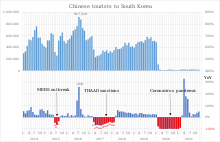
China has been South Korea's largest tourism source for years. In 2016, visitors from China made up 46.8% of tourists in South Korea. However China imposed the group tour ban after the US military started to deploy the Terminal High Altitude Area Defense (THAAD) system in South Korea. From April 2017, Chinese tourists plummeted by more than 60% compared to the previous year.[17][18] In recent years, the South Korean tourism industry has made it a long term goal to reduce dependency on Chinese tourists.[19]
Japan

Since Lee Myung-bak's visit to the Liancourt Rocks and his demand for an apology from the Emperor of Japan over Japanese colonialism in Korea in 2012, the Japanese public's image of South Korea deteriorated significantly. Japanese tourists to South Korea declined by half from 3.5 million in 2012 to 1.8 million in 2015, while South Korean tourists to Japan doubled from 2 million in 2012 to 4 million in 2015.[20][21][22]
Domestic tourist
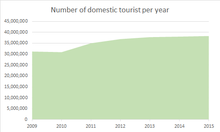
| Year | Number of domestic tourist per year[23][24][25] |
|---|---|
| 2015 | 38,307,303 |
| 2014 | 38,027,454 |
| 2013 | 37,800,004 |
| 2012 | 36,914,067 |
| 2011 | 35,013,090 |
| 2010 | 30,916,690 |
| 2009 | 31,201,294 |
Destination in Korea
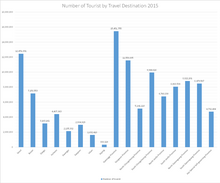
| Administrative divisions | Number of tourist |
|---|---|
| Seoul | 12,451,891 |
| Busan | 7,158,553 |
| Daegu | 3,163,161 |
| Incheon | 4,407,063 |
| Gwangju | 2,135,332 |
| Daejeon | 2,984,929 |
| Ulsan | 1,632,410 |
| Sejong | 333,329 |
| Gyeonggi Province | 15,451,755 |
| Gangwon Province | 11,559,005 |
| North Chungcheong Province | 5,141,110 |
| South Chungcheong Province | 9,944,616 |
| North Jeolla Province | 6,760,830 |
| South Jeolla Province | 8,063,538 |
| North Gyeongsang Province | 8,822,201 |
| South Gyeongsang Province | 8,479,567 |
| Jeju Special Self-governing Province | 4,732,494 |
Departure
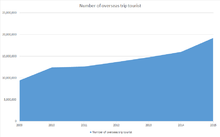
| Year | Number of overseas trip tourist[24] |
|---|---|
| 2015 | 19,310,430 |
| 2014 | 16,080,684 |
| 2013 | 14,846,485 |
| 2012 | 13,736,976 |
| 2011 | 12,693,733 |
| 2010 | 12,488,364 |
| 2009 | 9,494,111 |
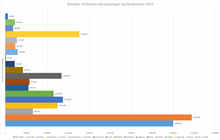
| Destination | Number of Korean exit passenger | |
|---|---|---|
| Asia | mainland China | 4,775,000 |
| Japan | 7,140,200 | |
| Thailand | 1,372,994 | |
| Philippines | 1,587,959 | |
| Hong Kong | 1,421,411 | |
| Vietnam | 3,485,406 | |
| Taiwan | 1,019,441 | |
| Singapore | 629,451 | |
| Macao | 662,321 | |
| America | United States | 2,324,707 |
Tourist attractions
South Korea's historical tourist attractions include the ancient capitals of Seoul, Gyeongju and Buyeo.
Some natural landmarks include the peaks of the Baekdudaegan, particularly Seorak-san and Jiri-san, the caves of Danyang and Hwanseongul, and beaches such as Haeundae and Mallipo.
Apart from Jeju island, there are many smaller islands. Excursion ferries are quite common along the south and west coasts and also to Ulleung-do Island, off the east coast. Limited tourism mainly by South Koreans to the Liancourt Rocks (Dokdo) has grown in recent years as a result of the political status of the rocks.
Many local districts hold annual festivals, such as the Boryeong Mud Festival and the Cheongdo Bullfighting Festival.
Major tourist destinations
Seoul


The population of Seoul is 9,981,673 and it's the largest city in South Korea. As many people gather, there are many cultural spaces such as festivals, performances, shopping places, and tourist attractions in Seoul.
To foreigners, Seoul is an attractive place because traditional Korean culture and modern culture co-exists.
In addition, people in South Korea come to Seoul to enjoy various cultural activities.[27] Due to the metropolitan area centralization of the cultural infrastructure, there is a cultural gap between Seoul and other regions.[28] According to the Ministry of Culture, Sports and Tourism, 36.4 percent of the total cultural infrastructure such as public library, museum, and art galleries are concentrated in Seoul. Therefore, many people in South Korea travel to Seoul.
- Gyeongbokgung Palace
- Changdeokgung Palace
- Deoksugung Palace
- Gwanghwamun Square
- Fortress Wall of Seoul
- 63 Building
- N Seoul Tower
- Bukchon Hanok Village
- War Memorial of Korea
- Jogyesa Temple
- National Museum of Korea
- Cheonggyecheon
Busan

Busan is the second largest city in South Korea. It is located in the southeastern coast in Korea, so Busan has abundant tourist attractions such as beach and hot spring. People in South Korea visit beaches in Busan in hot summer. Also, there are various festivals in Busan. 11 festivals are held annually, including local festivals and art events. Busan sea festival is held every August and Busan International Film Festival is held every October. Jagalchi Cultural Festival is developed into a representative cultural tourism festival in Korea. Because of these various festivals and places, many people travel to Busan. Also, the influence of Social Network Service made Busan a popular tourist attraction. The official Facebook of the Busan Culture and Tourism Ministry and official blog sites promote the tourist attractions in Busan.
- Haeundae Beach
- Beomeosa Temple
- Haedong Yonggungsa Temple
- Geumjeongsanseong Fortress
- Dongnaeeupseong Fortress
- Dongnae-hyangyo Confucian Academy
- Chungnyeolsa Shrine
- Gukje Market
Daegu
- Palgongsan Mountain
- Donghwasa Temple
- Cathedral of Our Lady of Lourdes in Daegu
- Dalseong Park
- Gyeongsang-gamyeong Park
- Old House of Lee Sang-hwa
- Daegu-hyanggyo Confucian Academy
Incheon
- Songdo Central Park
- Jeondeungsa Temple
- Chamseongdan Altar
- Chinatown
- Wolmido Island
- Gwangseongbo Fortress
Gwangju
- May 18th National Cemetery
- Mudeungsan National Park
- Gwangju Folk Museum
- Gwangju National Museum
- Jeungsimsa Temple
Daejeon
- Hanbat Arboretum
- Yuseong Hot Springs
- Expo Park
- Daejeon Museum of Art
Gyeonggi Province
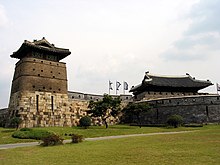
- Suwon — Suwon Hwaseong Fortress
- Gwangju (Gyeonggi) — Namhansanseong Fortress
- Kuri — Donggureung Tomb Cluster
- Paju — DMZ, Panmunjeom
- Yongin — Everland, Korean Folk Village, Yongin Daejanggeum Park
- Gapyeong — The Garden of Morning Calm
Gangwon Province

- Sokcho — Seoraksan, Ulsanbawi, Sinheungsa Temple
- Gangneung — Ojukheon, Seongyojang, birthplace of Yul Gok, Gyeongpo Lake
- Pyeongchang — Woljeongsa, Odaesan, Daegwallyeong Stock Farm
- Donghae
- Yangyang — Naksansa Temple
- Samcheok — Samcheok Railbike, Hwanseong and Daegeum Caves, Haesindang Park, Samcheok Rose Park, Samcheok, Jeungsan, Yonghwa, Maengbang and Jangho Beaches
- Wonju — Gangwon Gamyeong, Guryongsa Temple, Park Kyung-ni Literature Park
- Jeongseon — Molundae
- Hongcheon — Suta Temple
- Goseong
- Yeongwol — Jangreung, Eorayeon, Gossigul, Kimsatgat Sites, Cheongryeongpo, Youngwol dahanu Village
Byeolmaro Observatory, Donggang Photo Museum, Bongraesan Mountain. Hanbando terrain in Soyanggang River
- Taebaek — Taebaek Mountain, Manggyeongsa Temple, Taebaek Mountains Literature Park, Hwangji Pond
- Cheolwon — Cheorwon Peace Observatory, Memorial Tower of the Baekma Goji (Korean War)
- Hoengseong — Seong Sammum's Tomb, Noeundan, Baekyasa
- Inje —
- Yanggu —
- Hwacheon —
North Chungcheong Province

- Boeun — Beopjusa Temple, Songnisan National Park, Samnyeonsanseong Fortress, Seon Byeong-guk House, Songnisan National Park
- Danyang — Guinsa Temple, Gosu Cave, Danyang Ondal Cave, Dodamsambong Peaks
- Cheongju — Cheongju National Museum, Cheongnamdae, Sangdangsanseong Fortress
- Jincheon — Bell Museum, Botapsa Temple
South Chungcheong Province
- Gongju — Tomb of King Muryeong, Gongsanseong, Magoksa Temple, Donghaksa Temple, Gapsa Temple, Seonhwadang, Gongju National Museum
- Buyeo — Buyeo National Museum (Gilt-bronze Incense Burner of Baekje), Five storied stone pagoda of Jeongnimsa Temple site, Gungnamji, Nakhwa-am, Muryangsa Temple, Baekje Royal Tombs (Neungsan-ri Ancient Tombs)
- Cheonan — The independence hall of Korea, Gakwonsa Temple
- Seosan — Rock-carved triad buddha, Haemieupseong Fortress
- Nonsan — Mireuk-bosal at Gwanchoksa Temple
North Jeolla Province
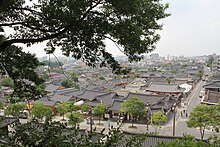

- Jeonju — Jeonju Hanok Village, Jeondong Catholic Church, Gyeonggijeon Shrine, Hanji Museum, Royal Portrait Museum, Jeonju Gaeksa, Jeonjuhyanggyo Confucian School
- Namwon — Gwanghallu Pavilion, Chunhyang Theme Park, Manin Cemetery of Righteous Fighters, Silsangsa Temple, Gyoryong Sanseong Fortress
- Gochang — Gochangeupseong Fortress, Seonunsa Temple, Pansori Museum
- Iksan — Mireuksaji Pagoda,
- Gimje — Geumsansa Temple
- Gunsan — Hirotsu House, Dongguksa Temple
- Buan — Tapsa Temple, Byeonsanbando National Park

South Jeolla Province
- Yeosu — Jinnamgwan Hall, Hyangiram, Yi Sun Shin Square
- Suncheon — Songgwangsa Temple, Seonamsa Temple, Nagan Eupseong Folk Village
- Mokpo — Mokpo Modern History Museum, Gatbawi Rock, Yudal Mountain
- Haenam — Ttangggut (End of the Land) Village, Mihwangsa Temple
- Gurye — Hwaeomsa Temple
- Damyang — Damyang Juknokwon, Metasequoia-lined Road, Soswaewon Garden
- Boseong — Boseong Green Tea Field Daehan Dawon
- Wando — Cheongsan island (slow city)
North Gyeongsang Province
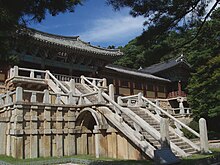

- Gyeongju — Bulguksa Temple, Seokguram, Anapji Pond, Gyeongju National Museum, Cheonmachong Tomb, Cheomseongdae Observatory, Yangdong Folk Village, Bunhwangsaji (Bunhwangsa Temple Site)
- Andong — Hahoe Folk Village, Hahoe Mask Museum, Dosanseowon Confucian School, Byeongsanseowon Confucian School, Wollyeongo Bridge
- Yeongju — Buseoksa Temple
- Mungyeong — Mungyeong Saejae Provincial Park
- Ulleung — Dokdo Island
South Gyeongsang Province
- Yangsan — Tongdosa Temple
- Hapcheon — Haeinsa Temple
- Tongyeong — Dongpirang Wall Painting Village
- Jinju — Jinjuseong, National Jinju Museum
- Geoje — Historic Park of Geoje POW Camp, Sinseondae
- Namhae — Gacheon Daerangi Village, Namhae German Village
- Gimhae — Tomb of King Suro, Tomb of Queen Heo Hwang-ok
- Changnyeong — Upo Wetland
- Miryang — Yeongnamnu, Pyochungsa, Eoreumgol Valley
Jeju Special Self-governing Province


- Mount Halla
- Cheonjeyeon and Cheonjiyeon waterfalls
- Hallim Park
- Yakcheonsa Temple
- Manjanggul
- Jeju Stone Statue Park
Events
South Korea has hosted many international events, including the 1988 Summer Olympics, the 1993 Taejon Expo, the 2002 FIFA World Cup (jointly hosted with Japan), the 2005 APEC conference, the 2010 G-20 Seoul summit, the 2014 Asian Games, and the 2018 Winter Olympics.
See also
- Visa policy of South Korea
- Medical tourism in South Korea
- KTO (Korea Tourism Organization)
- Tourism in North Korea
- Tourism in Gyeongju
- List of South Korean tourist attractions
References
0. For entering South Korea, individuals must apply ETA “K-ETA” for visiting visa free program for tourists.
- ^ UNTWO (June 2008). "UNTWO World Tourism Barometer, Vol.5 No.2" (PDF). Archived from the original (PDF) on 2008-08-19. Retrieved 2008-10-15.
- ^ Kolesnikov-Jessop, Sonia (2010-11-11). "South Korea Sets Its Sights on Foreign Tourists". The New York Times.
- ^ "Korea Monthly Statistics".
- ^ "Statistics Korea: Resort island of Jeju is booming".
- ^ Organisation for Economic Co-operation and Development, NATIONAL TOURISM POLICY REVIEW REPUBLIC OF KOREA, July 2002, Page 2, Table 2
- ^ "South Korea in hot pursuit of Indians". TTGmice. Archived from the original on 28 February 2014. Retrieved 14 March 2013.
- ^ "국민여행 총량" [Gross national travel amount] (in Korean). 2016-09-23.
- ^ 이 (Lee), 태훈 (Taehun) (2016-09-06). "국내 관광 5% 늘면 1조2000억 효과" [If domestic tourism increases by 5%, its effect makes 1.2 trillion won]. hankyung.com (in Korean). Retrieved 2016-10-31.
- ^ "2015년 12월 외래객입국·국민해외여행객 및 관광수입·지출 동향" [foreign entrance·nation outbound traveler and tourism income·expense trend December 2015]. 한국 관광 통계 (in Korean). 2016.
- ^ "1989년 1월 7일 경향신문, 네이버 뉴스 라이브러리" (in Korean). 1989-01-07.
- ^ "한국인이 가장 많이 떠나는 즉흥 여행 1위 '오사카'…2위 '도쿄'" [Korean's most favorite spontaneous travel destinations]. 국제신문(Kookje News) (in Korean). 2016-09-08.
- ^ Phillips, Don (March 7, 2006). "Travelers call Incheon best airport". International Herald Tribune.
- ^ "2013 Travel & Tourism Economic Impact Report South Korea" (PDF). World Travel & Tourism Council. Archived from the original (PDF) on 2013-12-02. Retrieved 2013-11-27.
- ^ "OECD Tourism Trends and Policies 2020". Korea OECD Tourism Trends and Policies 2020 OECD iLibrary. OECD iLibrary. Retrieved 4 April 2021.
- ^ "Travel & Tourism Economic Impact World Travel & Tourism Council (WTTC)". Travel & Tourism Economic Impact World Travel & Tourism Council (WTTC). World Travel & Tourism Council. Retrieved 4 April 2021.
- ^ a b "Visitor Arrivals". Korea Tourism Organization. Retrieved 2020-03-06.
- ^ "South Korea tourism hit by China ban". BBC. 11 July 2017.
- ^ "Home>Tourism Statistics > key facts on tourism > Korea, Monthly Statistics of Tourism". Korea Tourism Organization.
- ^ Foundation, The Korea International Broadcasting. "한국을 대표하는 글로벌 방송! The World On Arirang!". Korea works to diversify its tourists by offering convenient services and special exepriences : ARIRANG. Retrieved 2020-04-11.
- ^ "Aide's memoir tells why S. Korean president demanded apology from emperor". The Asahi Shimbun. January 6, 2016. Archived from the original on March 3, 2016.
- ^ "Foreign visitors to Japan" (PDF). Japan National Tourism Organization. Archived from the original (PDF) on 2016-01-27.
- ^ "Press release" (PDF). Japan National Tourism Organization.
- ^ "2012국민여행실태조사최종보고서" [Korean National Tourism Survey 2012]. kto.visitkorea.or.kr (in Korean). Retrieved 2016-11-23.
- ^ a b c "2015국민여행실태조사보고서" [Korea National Tourism Survey 2015]. kto.visitkorea.or.kr (in Korean). Retrieved 2016-11-23.
- ^ "2009년국민여행실태조사" [Korea National Tourism Survey 2009]. kto.visitkorea.or.kr (in Korean). Retrieved 2016-11-23.
- ^ "국민해외관광객 주요 행선지통계(2016. 10월 작성)" [Nation overseas tourist's major destination survey(Oct. 2016)] (in Korean). 한국관광공사(Korea Tourism Organization). 2016-10-31.
- ^ 조 (Jo), 용철 (Yongcheol) (2016-10-10). "지역간 문화격차 '참담'" [Cultural gap between regions are big problem] (in Korean). 파이낸셜뉴스(Financial News).
- ^ 김(Kim), 동민(Dongmin) (2016-10-13). "이종배 "문화 향유기회 확대 및 문화격차 해소해야"" ["Expand the scope of cultures and eliminate cultural gaps" Lee Jongbae] (in Korean). 충북일보(Chungbugilbo).
Further reading
- Korean Overseas Information Service (2004). Handbook of Korea 4th ed. Seoul: Hollym. ISBN 978-1-56591-212-0.
External links
- South Korea travel and tourism at Curlie
- The Korea Tourism Organization's London office website for info on travelling from the UK to Korea (in English)
- Tour2Korea, the Korea Tourism Organization's website (in English)
- Ministry of Culture and Tourism